ETECADx: Ensemble Self-Attention Transformer Encoder for Breast Cancer Diagnosis Using Full-Field Digital X-ray Breast Images
Abstract
1. Introduction
- A novel CAD system is designed to accurately and rapidly predict the breast cancer based on the hybrid scenario of ensemble transfer learning as well as the emerging transformer-based approach.
- Automatic image processing-based breast lesions region of interest (ROIs) extraction from the entire mammograms to perform more accurate trainable parameters during the fine-tuning process of the proposed AI models.
- A comprehensive experimental study over binary and multi-class approaches is conducted using the benchmark INbreast dataset in terms of selecting the proper AI models for the ensemble learning, achieving accurate and rapid prediction performance, and establishing reliable and feasible CAD system.
- An ablation study is performed to show the contribution of each ETECADx component in order to improve the diagnosis performance of the breast cancer.
- To validate and verify the proposed ETECADx framework, a private breast cancer real dataset is collected and annotated by three expert radiologists.
2. Related Work
2.1. Deep Learning Based-CNN for Medical Breast Imaging
2.2. Ensemble Learning as a Backbone for Accurate Deep Feature Generation
2.3. Vision Transformer-Based Medical Image Classification
3. Material and Methodology
3.1. The Proposed AI-Based ETECADx Framework
3.2. Dataset: Digital X-ray Mammograms
3.2.1. INbreast Public Dataset
3.2.2. Private Real Breast Images
3.3. Medical Data Preprocessing
3.4. Patch Image Extraction
| Algorithm 1: Patch Image Extraction via Image Preprocessing Approach | |
| Start: Input: Original image with its mask Step 1: load data | |
| Image Mask cv | ← image; {read DICOM image format} ← mask; {load mask from XML file} ← openCV2; {python library for computer vision task} |
| Step 2: Applybitwise_AND Image ← cv2.bitwise_and (Original Image, Mask, cv2.COLOR_BGR2GRAY) Step 2: Binary thresholding
| |
| Algorithm 2: Patch Image Extraction for Normal Cases |
| 1. START: 2. def tile (image,input_path,output_path,dim) { 3. Declare name, ext, image, w, h 4. image = Image.open (os.path(image)) 5. w, h = Image.size 6. grid = product (range(0, h-h%d, d), range(0, w-w%d, d)) 7. FOR i, j in grid: 8. box = (j, i, j + d, i + dim) 9. out = os.path.join(dir_out, f’{name}_{i}_{j}{ext}’) 10. img.crop(box).save(out) 11. ENDFOR 12. END Ignore the images with the majority in black 1. START 2. zero = skimage.io.imread(fname = image_name) 3. declare black_counter = 0 4. for i in range (image.size [1]): 5. for j in range (image.size [0]): 6. if zero[i,j].any() <=0: 7. black_counter = black_counter + 1 8. if black_counter<=image.size/4: 9. shutil. copy2 (image_name, new_path) END |
3.5. Data Preparation for Training, Validation, and Testing
3.6. Training Data Augmentation
3.7. Ensemble Transfer Learning
- AI-based VGG16: VGG16 is one of the popular CNN pre-trained models used for classification tasks. In this work, the classification layers from the pre-trained VGG16 model that was trained on the ImageNet dataset were deleted before this model is applied. Therefore, a new classification layer is added for binary and multi-classification, in which the highest performance is achieved. A conventional layer with 1024 neurons, batch normalization, and dropout (50% of dropout rate) layers are added, respectively. The fine-tune used for binary and multi-classification is 17, in which all layers starting from the layer number 17 to the classification layers are trainable, while the rest are untrainable.
- AI-based ResNet: ResNet is a deep convolutional neural network with 50 layers that has been used for image identification applications. ResNet50 was trained using the ImageNet dataset for classifying almost 1000 classes, similar to the pre-trained VGG16 model, and the classification layers are also deleted. We add the same layers for binary and multiple classifications, just like in the AI-based VGG16 in the above section. Two fine-tuned configurations are applied for the ResNet50 model: 143 is used for binary classification and 123 is applied for multi-classification, since they recorded the highest performance.
- AI-based DenseNet201: All layers in the DenseNet model are linked together in a feedforward approach. Each successive layer receives its own feature maps and also receives inputs from all preceding levels [53]. The structure is finished with the addition of global average pooling, one fully connected layer, and a SoftMax layer. All training is done on the fine-tune layer, with a fine-tune value of 481. This is utilized for both binary and multi-classification approaches.
- AI-based GoogleNet: The purpose of developing this model was to solve the issue of overfitting whilst also delving further into the network layer [54]. Out of a total of 311 layers structured into convolution layers, max-pooling layers with nine linearly stacked Inception modules, 252 are trained using fine tuning. Then, global pooling is added with one fully connected layer and output layer.
- AI-based InceptionResNetV2: The network architecture is similar to that of InceptionResNetV1, but the stem is based on InceptionV4 [55]. On the far left of each module is a shortcut link. For better classification results, it blends inception architecture with residual connections. The convolutional operation in the inception module needs to take the same input and output for the inception convolutional operation.
- AI-based Xception: This is a stack of linearly connected convolution layers that can be separated by their depth. It is made up of 36 convolutional layers that are organized into 14 modules. Each module has linear residual connections around it, which serve as the network’s backbone for extracting features [56].
3.8. The Proposed Hybrid AI Model
3.9. Experimental Setup
3.10. Evaluation Strategy
3.11. Execution Environment
4. Experimental Results
4.1. Approach A: Binary Classification Results
4.1.1. Individual Pre-Trained Deep Learning Models
4.1.2. Ensemble Learning vs. the Proposed ETECADx
4.2. Approach B: Multi-Classification Results
4.2.1. Individual Pre-Trained Deep Learning Models
4.2.2. Ensemble Learning vs. the Proposed ETECADx
5. Discussion
5.1. The Findings of the Binary Approach
5.2. Multi-Classification Approach Findings
5.3. Ablation Study Using the Real Breast Image Dataset
5.3.1. Approach A: Binary Classification Approach
5.3.2. Approach B: Multi-Class Classification Approach
5.4. Comparison Evaluation Results against the Latest Research Works
5.5. Limitations and Future Work
6. Conclusions
Author Contributions
Funding
Institutional Review Board Statement
Informed Consent Statement
Data Availability Statement
Acknowledgments
Conflicts of Interest
Abbreviations
| AI | Artificial Intelligence |
| XAI | Explainable AI |
| CAD | Computer-Aided Diagnosis |
| CC | Cranio-Caudal |
| MLO | Mediolateral Oblique |
| CNN | Convolution Neural Network |
| DICOM | Digital Imaging and Communications in Medicine |
| ROI | Regions of Interest |
| MLP | Multiple Layer Perceptron |
| TE | Transformer Encoder |
| GT | Ground Truth |
| PCA | Principal Component Analysis |
| ViT | Vision Transformer |
| FP | False Positive |
| MSA | Multi-head self-attention |
| GAN | Generative Adversarial Network Ok, Confirm |
References
- Al-Tam, R.M.; Narangale, S.M. Breast Cancer Detection and Diagnosis Using Machine Learning: A Survey. J. Sci. Res. 2021, 65, 265–285. [Google Scholar] [CrossRef]
- Al-Tam, R.M.; Al-Hejri, A.M.; Narangale, S.M.; Samee, N.A.; Mahmoud, N.F.; Al-Masni, M.A.; Al-Antari, M.A. A Hybrid Workflow of Residual Convolutional Transformer Encoder for Breast Cancer Classification Using Digital X-ray Mammograms. Biomedicines 2022, 10, 2971. [Google Scholar] [CrossRef] [PubMed]
- Samee, N.A.; Atteia, G.; Meshoul, S.; Al-Antari, M.A.; Kadah, Y.M. Deep Learning Cascaded Feature Selection Framework for Breast Cancer Classification: Hybrid CNN with Univariate-Based Approach. Mathematics 2022, 10, 3631. [Google Scholar] [CrossRef]
- Ghosh, D.; Ghosh, D.E. An Overview and Study of CAD Systems for Mass Detec-tion and Classification and Mammography for the Detection of Breast Cancer. Acta Biol. Forum 2022, 27–39. [Google Scholar] [CrossRef]
- Sung, H.; Ferlay, J.; Siegel, R.L.; Laversanne, M.; Soerjomataram, I.; Jemal, A.; Bray, F. Global cancer statistics 2020: GLOBOCAN estimates of incidence and mortality worldwide for 36 cancers in 185 countries. CA Cancer J. Clin. 2021, 71, 209–249. [Google Scholar] [CrossRef] [PubMed]
- Arnold, M.; Morgan, E.; Rumgay, H.; Mafra, A.; Singh, D.; Laversanne, M.; Vignat, J.; Gralow, J.R.; Cardoso, F.; Siesling, S.; et al. Current and future burden of breast cancer: Global statistics for 2020 and 2040. Breast 2022, 66, 15–23. [Google Scholar] [CrossRef] [PubMed]
- Siddiqui, M.; Anand, M.; Mehrotra, P.; Sarangi, R.; Mathur, N. Biomonitoring of organochlorines in women with benign and malignant breast disease. Environ. Res. 2005, 98, 250–257. [Google Scholar] [CrossRef]
- Oza, P.; Sharma, P.; Patel, S.; Bruno, A. A Bottom-Up Review of Image Analysis Methods for Suspicious Region Detection in Mammograms. J. Imaging 2021, 7, 190. [Google Scholar] [CrossRef]
- Al-Antari, M.A.; Al-Masni, M.; Park, S.-U.; Park, J.; Metwally, M.K.; Kadah, Y.M.; Han, S.-M.; Kim, T.-S. An automatic computer-aided diagnosis system for breast cancer in digital mammograms via deep belief network. J. Med. Biol. Eng. 2018, 38, 443–456. [Google Scholar] [CrossRef]
- Al-Antari, M.A.; Han, S.-M.; Kim, T.-S. Evaluation of deep learning detection and classification towards computer-aided diagnosis of breast lesions in digital X-ray mammograms. Comput. Methods Programs Biomed. 2020, 196, 105584. [Google Scholar] [CrossRef] [PubMed]
- Ukwuoma, C.C.; Qin, Z.; Bin Heyat, B.; Akhtar, F.; Bamisile, O.; Muaad, A.Y.; Addo, D.; Al-Antari, M.A. A Hybrid Explainable Ensemble Transformer Encoder for Pneumonia Identification from Chest X-ray Images. J. Adv. Res. 2022, in press. [Google Scholar]
- Kooi, T.; Litjens, G.; van Ginneken, B.; Gubern-Mérida, A.; Sánchez, C.I.; Mann, R.; den Heeten, A.; Karssemeijer, N. Large scale deep learning for computer aided detection of mammographic lesions. Med. Image Anal. 2017, 35, 303–312. [Google Scholar] [CrossRef] [PubMed]
- Xi, P.; Shu, C.; Goubran, R. Abnormality detection in mammography using deep convolutional neural networks. In Proceedings of the 2018 IEEE International Symposium on Medical Measurements and Applications (MeMeA), Rome, Italy, 11–13 June 2018; pp. 1–6. [Google Scholar]
- Hou, R.; Peng, Y.; Grimm, L.J.; Ren, Y.; Mazurowski, M.A.; Marks, J.R.; King, L.M.; Maley, C.C.; Hwang, E.S.; Lo, J.Y. Anomaly Detection of Calcifications in Mammography Based on 11,000 Negative Cases. IEEE Trans. Biomed. Eng. 2021, 69, 1639–1650. [Google Scholar] [CrossRef] [PubMed]
- Melekoodappattu, J.G.; Dhas, A.S.; Kandathil, B.K.; Adarsh, K.S. Breast cancer detection in mammogram: Combining modified CNN and texture feature based approach. J. Ambient Intell. Humaniz. Comput. 2022, 1–10. [Google Scholar] [CrossRef]
- Pillai, A.; Nizam, A.; Joshee, M.; Pinto, A.; Chavan, S. Breast Cancer Detection in Mammograms Using Deep Learning. In Applied Information Processing Systems; Springer: Berlin/Heidelberg, Germany, 2022; pp. 121–127. [Google Scholar]
- Mahmood, T.; Li, J.; Pei, Y.; Akhtar, F.; Rehman, M.U.; Wasti, S.H. Breast lesions classifications of mammographic images using a deep convolutional neural network-based approach. PLoS ONE 2022, 17, e0263126. [Google Scholar] [CrossRef]
- Chakravarthy, S.R.S.; Bharanidharan, N.; Rajaguru, H. Multi-Deep CNN based Experimentations for Early Diagnosis of Breast Cancer. IETE J. Res. 2022, 1–16. [Google Scholar] [CrossRef]
- Gaona, Y.J.; Lakshminarayanan, V. DenseNet for Breast Tumor Classification in Mammographic Images. In Proceedings of the Bioengineering and Biomedical Signal and Image Processing: First International Conference, BIOMESIP 2021, Meloneras, Gran Canaria, Spain, 19–21 July 2021; Volume 12940, p. 166. [Google Scholar]
- Shen, L.; Margolies, L.R.; Rothstein, J.H.; Fluder, E.; McBride, R.; Sieh, W. Deep Learning to Improve Breast Cancer Detection on Screening Mammography. Sci. Rep. 2019, 9, 12495. [Google Scholar] [CrossRef]
- Roy, A.; Singh, B.K.; Banchhor, S.K.; Verma, K. Segmentation of malignant tumours in mammogram images: A hybrid approach using convolutional neural networks and connected component analysis. Expert Syst. 2022, 39, e12826. [Google Scholar] [CrossRef]
- Aly, G.H.; Marey, M.; El-Sayed, S.A.; Tolba, M.F. YOLO Based Breast Masses Detection and Classification in Full-Field Digital Mammograms. Comput. Methods Programs Biomed. 2021, 200, 105823. [Google Scholar] [CrossRef]
- Tabrizchi, H.; Tabrizchi, M.; Tabrizchi, H. Breast cancer diagnosis using a multi-verse optimizer-based gradient boosting decision tree. SN Appl. Sci. 2020, 2, 752. [Google Scholar] [CrossRef]
- Hamed, G.; Marey, M.; Amin, S.E.; Tolba, M.F. Automated Breast Cancer Detection and Classification in Full Field Digital Mammograms Using Two Full and Cropped Detection Paths Approach. IEEE Access 2021, 9, 116898–116913. [Google Scholar] [CrossRef]
- Al-Masni, M.A.; Al-Antari, M.A.; Park, J.-M.; Gi, G.; Kim, T.-Y.; Rivera, P.; Valarezo, E.; Choi, M.-T.; Han, S.-M. Simultaneous detection and classification of breast masses in digital mammograms via a deep learning YOLO-based CAD system. Comput. Methods Programs Biomed. 2018, 157, 85–94. [Google Scholar] [CrossRef] [PubMed]
- Mutar, M.T.; Goyani, M.S.; Had, A.M.; Mahmood, A.S. Pattern of presentation of patients with breast cancer in Iraq in 2018: A cross-sectional study. J. Glob. Oncol. 2019, 5, 1–6. [Google Scholar] [CrossRef] [PubMed]
- Ragab, D.A.; Attallah, O.; Sharkas, M.; Ren, J.; Marshall, S. A framework for breast cancer classification using multi-DCNNs. Comput. Biol. Med. 2021, 131, 104245. [Google Scholar] [CrossRef] [PubMed]
- Ma, J.; Yuan, Y. Dimension reduction of image deep feature using PCA. J. Vis. Commun. Image Represent. 2019, 63, 102578. [Google Scholar] [CrossRef]
- Hamed, G.; Marey, M.A.E.-R.; Amin, S.E.-S.; Tolba, M.F. The mass size effect on the breast cancer detection using 2-levels of evaluation. In Proceedings of the International Conference on Advanced Intelligent Systems and Informatics, Cairo, Egypt, 19–21 October 2020; pp. 324–335. [Google Scholar]
- Oza, P.; Sharma, P.; Patel, S.; Kumar, P. Deep convolutional neural networks for computer-aided breast cancer diagnostic: A survey. Neural Comput. Appl. 2022, 34, 1815–1836. [Google Scholar] [CrossRef]
- Hosni, M.; Abnane, I.; Idri, A.; de Gea, J.M.C.; Alemán, J.L.F. Reviewing ensemble classification methods in breast cancer. Comput. Methods Programs Biomed. 2019, 177, 89–112. [Google Scholar] [CrossRef]
- Altameem, A.; Mahanty, C.; Poonia, R.C.; Saudagar, A.K.J.; Kumar, R. Breast Cancer Detection in Mammography Images Using Deep Convolutional Neural Networks and Fuzzy Ensemble Modeling Techniques. Diagnostics 2022, 12, 1812. [Google Scholar] [CrossRef]
- Chakravarthy, S.R.S.; Rajaguru, H. Automatic detection and classification of mammograms using improved extreme learning machine with deep learning. IRBM 2022, 43, 49–61. [Google Scholar] [CrossRef]
- Thuy, M.B.H.; Hoang, V.T. Fusing of deep learning, transfer learning and gan for breast cancer histopathological image classification. In Proceedings of the International Conference on Computer Science, Applied Mathematics and Applications, Hanoi, Vietman, 19–20 December 2019; pp. 255–266. [Google Scholar]
- Savelli, B.; Bria, A.; Molinara, M.; Marrocco, C.; Tortorella, F. A multi-context CNN ensemble for small lesion detection. Artif. Intell. Med. 2020, 103, 101749. [Google Scholar] [CrossRef]
- Sahu, Y.; Tripathi, A.; Gupta, R.K.; Gautam, P.; Pateriya, R.K.; Gupta, A. A CNN-SVM based computer aided diagnosis of breast Cancer using histogram K-means segmentation technique. Multimed. Tools Appl. 2022, 1–21. [Google Scholar] [CrossRef]
- Samee, N.A.; Alhussan, A.A.; Ghoneim, V.F.; Atteia, G.; Alkanhel, R.; Al-Antari, M.A.; Kadah, Y.M. A Hybrid Deep Transfer Learning of CNN-Based LR-PCA for Breast Lesion Diagnosis via Medical Breast Mammograms. Sensors 2022, 22, 4938. [Google Scholar] [CrossRef] [PubMed]
- Gheflati, B.; Rivaz, H. Vision Transformers for Classification of Breast Ultrasound Images. In Proceedings of the 2022 44th Annual International Conference of the IEEE Engineering in Medicine & Biology Society (EMBC), Scotland, UK, 11–15 July 2022; pp. 480–483. [Google Scholar] [CrossRef]
- Vaswani, A.; Shazeer, N.; Parmar, N.; Uszkoreit, J.; Jones, L.; Gomez, A.N.; Kaiser, Ł.; Polosukhin, I. Attention is all you need. Adv. Neural Inf. Process. Syst. 2017, 30, 5998–6008. [Google Scholar]
- Qu, X.; Lu, H.; Tang, W.; Wang, S.; Zheng, D.; Hou, Y.; Jiang, J. A VGG attention vision transformer network for benign and malignant classification of breast ultrasound images. Med. Phys. 2022, 49, 5787–5798. [Google Scholar] [CrossRef] [PubMed]
- Wang, W.; Jiang, R.; Cui, N.; Li, Q.; Yuan, F.; Xiao, Z. Semi-supervised vision transformer with adaptive token sampling for breast cancer classification. Front. Pharmacol. 2022, 13, 929755. [Google Scholar] [CrossRef]
- Chen, X.; Zhang, K.; Abdoli, N.; Gilley, P.W.; Wang, X.; Liu, H.; Zheng, B.; Qiu, Y. Transformers Improve Breast Cancer Diagnosis from Unregistered Multi-View Mammograms. Diagnostics 2022, 12, 1549. [Google Scholar] [CrossRef]
- He, Z.; Lin, M.; Xu, Z.; Yao, Z.; Chen, H.; Alhudhaif, A.; Alenezi, F. Deconv-transformer (DecT): A histopathological image classification model for breast cancer based on color deconvolution and transformer architecture. Inf. Sci. (N. Y.) 2022, 608, 1093–1112. [Google Scholar] [CrossRef]
- Tummala, S.; Kim, J.; Kadry, S. BreaST-Net: Multi-Class Classification of Breast Cancer from Histopathological Images Using Ensemble of Swin Transformers. Mathematics 2022, 10, 4109. [Google Scholar] [CrossRef]
- Breast Cancer Treatment. National Cancer Institute. Available online: https://www.cancer.gov/types/breast/patient/breast-treatment-pdq#section/all?redirect=true (accessed on 22 December 2022).
- Al-antari, M.A.; Al-masni, M.A.; Choi, M.-T.; Han, S.-M.; Kim, T.-S. A fully integrated computer-aided diagnosis system for digital X-ray mammograms via deep learning detection, segmentation, and classification. Int. J. Med. Inform. 2018, 117, 44–54. [Google Scholar] [CrossRef]
- Moreira, I.C.; Amaral, I.; Domingues, I.; Cardoso, A.; Cardoso, M.J.; Cardoso, J.S. INbreast. Acad. Radiol. 2012, 19, 236–248. [Google Scholar] [CrossRef]
- Montaha, S.; Azam, S.; Rafid, A.K.M.R.H.; Ghosh, P.; Hasan, Z.; Jonkman, M.; De Boer, F. BreastNet18: A High Accuracy Fine-Tuned VGG16 Model Evaluated Using Ablation Study for Diagnosing Breast Cancer from Enhanced Mammography Images. Biology 2021, 10, 1347. [Google Scholar] [CrossRef]
- Al-Rahlawee, A.T.H.; Rahebi, J. Multilevel thresholding of images with improved Otsu thresholding by black widow optimization algorithm. Multimed. Tools Appl. 2021, 80, 28217–28243. [Google Scholar] [CrossRef]
- Chlap, P.; Min, H.; Vandenberg, N.; Dowling, J.; Holloway, L.; Haworth, A. A review of medical image data augmentation techniques for deep learning applications. J. Med. Imaging Radiat. Oncol. 2021, 65, 545–563. [Google Scholar] [CrossRef] [PubMed]
- Oza, P.; Sharma, P.; Patel, S.; Adedoyin, F.; Bruno, A. Image Augmentation Techniques for Mammogram Analysis. J. Imaging 2022, 8, 141. [Google Scholar] [CrossRef] [PubMed]
- Zhang, Q.-L.; Yang, Y.-B. SA-Net: Shuffle Attention for Deep Convolutional Neural Networks. In Proceedings of the ICASSP 2021—2021 IEEE International Conference on Acoustics, Speech and Signal Processing (ICASSP), Toronto, ON, Canada, 6–11 June 2021; pp. 2235–2239. [Google Scholar] [CrossRef]
- Jaiswal, A.; Gianchandani, N.; Singh, D.; Kumar, V.; Kaur, M. Classification of the COVID-19 infected patients using DenseNet201 based deep transfer learning. J. Biomol. Struct. Dyn. 2021, 39, 5682–5689. [Google Scholar] [CrossRef]
- Szegedy, C.; Liu, W.; Jia, Y.; Sermanet, P.; Reed, S.; Anguelov, D.; Erhan, D.; Vanhoucke, V.; Rabinovich, A. Going Deeper with Convolutions. In Proceedings of the IEEE Conference on Computer Vision and Pattern Recognition, Boston, MA, USA, 7–12 June 2015; pp. 1–9. Available online: https://www.cv-foundation.org/openaccess/content_cvpr_2015/html/Szegedy_Going_Deeper_With_2015_CVPR_paper.html (accessed on 22 December 2022).
- Szegedy, C.; Ioffe, S.; Vanhoucke, V.; Alemi, A. Inception-v4, Inception-ResNet and the Impact of Residual Connections on Learning. Proc. AAAI Conf. Artif. Intell. 2017, 31. [Google Scholar] [CrossRef]
- Chollet, F. Xception: Deep Learning with Depthwise Separable Convolutions. In Proceedings of the 2017 IEEE Conference on Computer Vision and Pattern Recognition (CVPR), Honolulu, HI, USA, 21–26 July 2017; pp. 1800–1807. [Google Scholar] [CrossRef]
- Dong, X.; Yu, Z.; Cao, W.; Shi, Y.; Ma, Q. A survey on ensemble learning. Front. Comput. Sci. 2020, 14, 241–258. [Google Scholar] [CrossRef]
- Han, K.; Wang, Y.; Chen, H.; Chen, X.; Guo, J.; Liu, Z.; Tang, Y.; Xiao, A.; Xu, C.; Xu, Y.; et al. A Survey on Vision Transformer. IEEE Trans. Pattern Anal. Mach. Intell. 2022, 45, 87–110. [Google Scholar] [CrossRef]
- Al-antari, M.A.; Hua, C.-H.; Bang, J.; Lee, S. Fast deep learning computer-aided diagnosis of COVID-19 based on digital chest x-ray images. Appl. Intell. 2021, 51, 2890–2907. [Google Scholar] [CrossRef]
- Pedregosa, F.; Varoquaux, G.; Gramfort, A.; Michel, V.; Thirion, B.; Grisel, O.; Blondel, M.; Prettenhofer, P.; Weiss, R.; Dubourg, V.; et al. Scikit-learn: Machine learning in Python. J. Mach. Learn. Res. 2011, 12, 2825–2830. [Google Scholar]
- Chola, C.; Muaad, A.Y.; Bin Heyat, B.; Benifa, J.V.B.; Naji, W.R.; Hemachandran, K.; Mahmoud, N.F.; Samee, N.A.; Al-Antari, M.A.; Kadah, Y.M.; et al. BCNet: A Deep Learning Computer-Aided Diagnosis Framework for Husssman Peripheral Blood Cell Identification. Diagnostics 2022, 12, 2815. [Google Scholar] [CrossRef]
- Lee, S.; Amgad, M.; Masoud, M.; Subramanian, R.; Gutman, D.; Cooper, L. An Ensemble-based Active Learning for Breast Cancer Classification. In Proceedings of the 2019 IEEE International Conference on Bioinformatics and Biomedicine (BIBM), San Diego, CA, USA, 18–21 November 2019; pp. 2549–2553. [Google Scholar] [CrossRef]
- Kadam, V.J.; Jadhav, S.M.; Vijayakumar, K. Breast Cancer Diagnosis Using Feature Ensemble Learning Based on Stacked Sparse Autoencoders and Softmax Regression. J. Med. Syst. 2019, 43, 263. [Google Scholar] [CrossRef] [PubMed]
- Moon, W.K.; Lee, Y.-W.; Ke, H.-H.; Lee, S.H.; Huang, C.-S.; Chang, R.-F. Computer-aided diagnosis of breast ultrasound images using ensemble learning from convolutional neural networks. Comput. Methods Programs Biomed. 2020, 190, 105361. [Google Scholar] [CrossRef] [PubMed]
- Abbasniya, M.R.; Sheikholeslamzadeh, S.A.; Nasiri, H.; Emami, S. Classification of Breast Tumors Based on Histopathology Images Using Deep Features and Ensemble of Gradient Boosting Methods. Comput. Electr. Eng. 2022, 103, 108382. [Google Scholar] [CrossRef]
- Jiang, J.; Peng, J.; Hu, C.; Jian, W.; Wang, X.; Liu, W. Breast cancer detection and classification in mammogram using a three-stage deep learning framework based on PAA algorithm. Artif. Intell. Med. 2022, 134, 102419. [Google Scholar] [CrossRef] [PubMed]
- Langer, M.; Oster, D.; Speith, T.; Hermanns, H.; Kästner, L.; Schmidt, E.; Sesing, A.; Baum, K. What do we want from Explainable Artificial Intelligence (XAI)?—A stakeholder perspective on XAI and a conceptual model guiding interdisciplinary XAI research. Artif. Intell. 2021, 296, 103473. [Google Scholar] [CrossRef]
- Nguyen, D.C.; Pham, Q.-V.; Pathirana, P.N.; Ding, M.; Seneviratne, A.; Lin, Z.; Dobre, O.; Hwang, W.-J. Federated Learning for Smart Healthcare: A Survey. ACM Comput. Surv. 2023, 55, 1–37. [Google Scholar] [CrossRef]

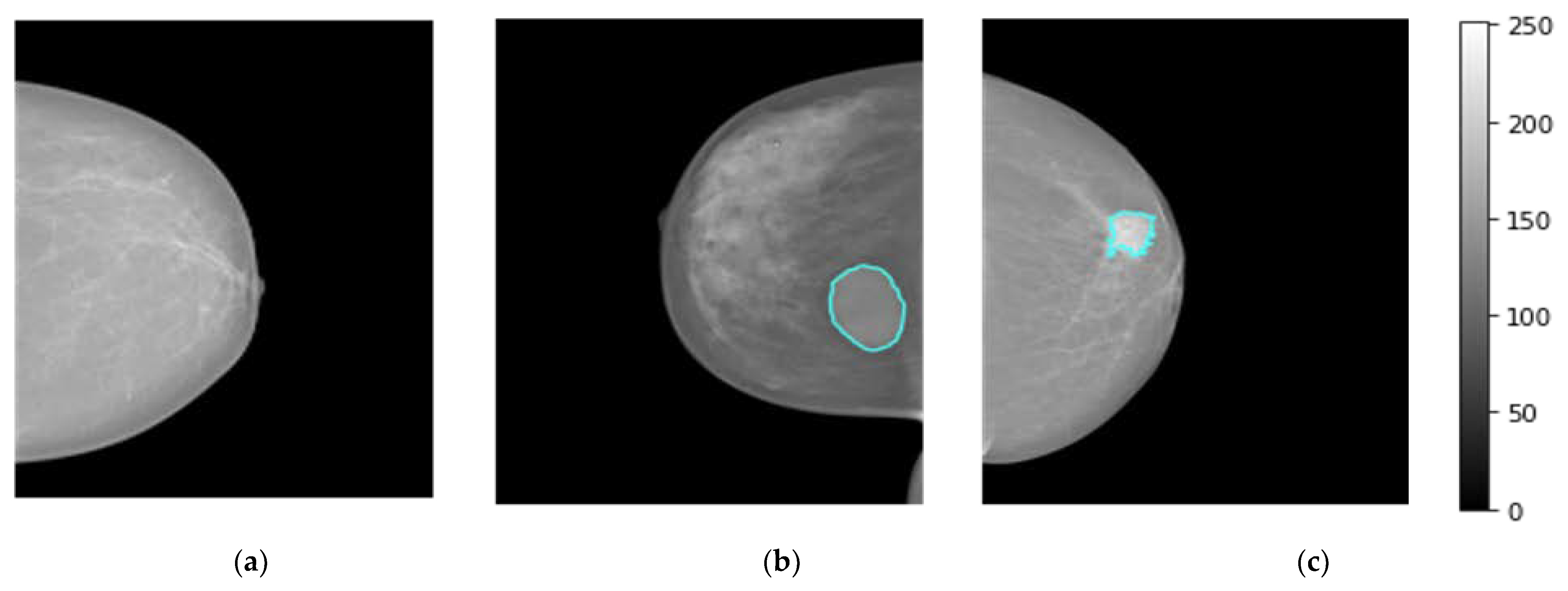



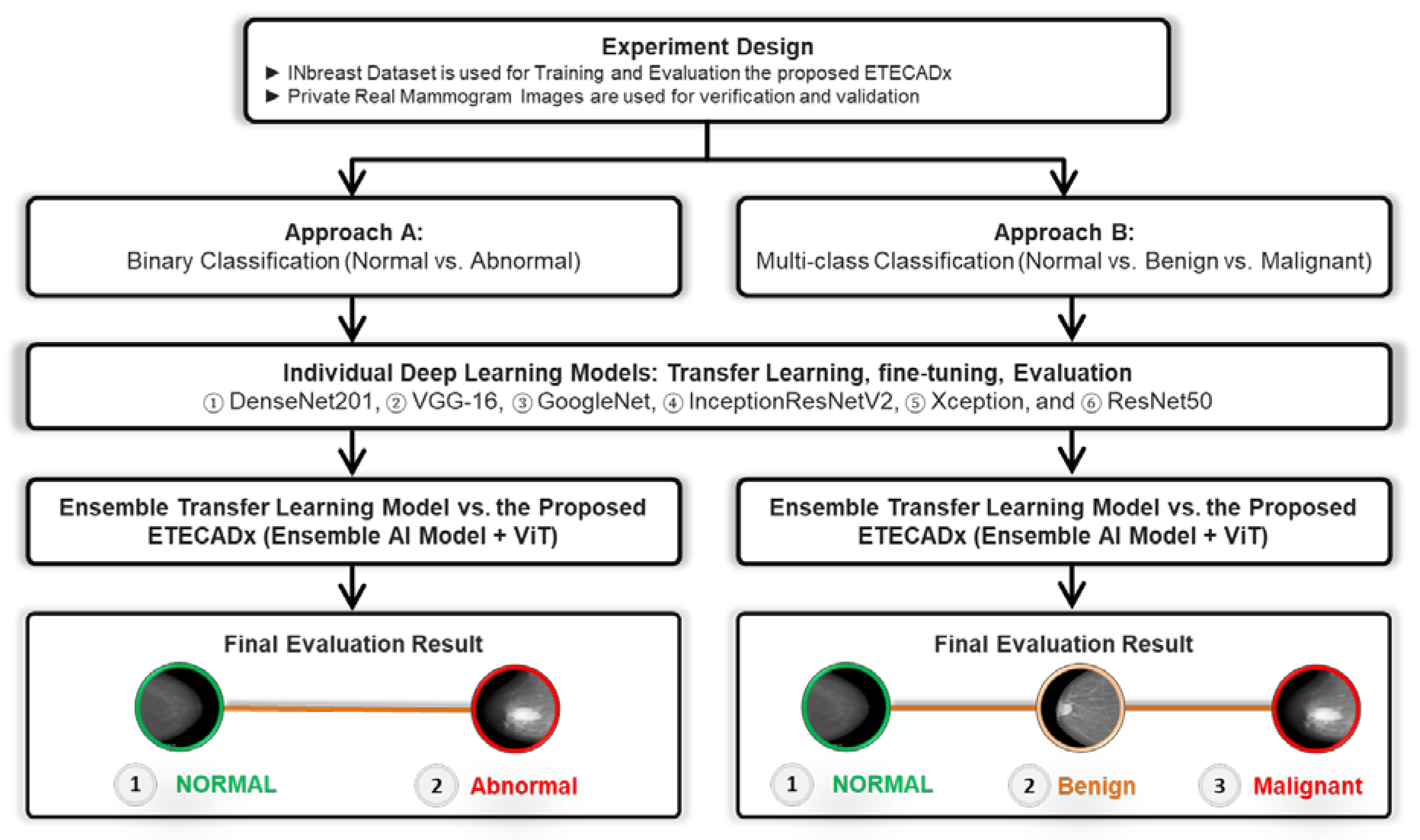
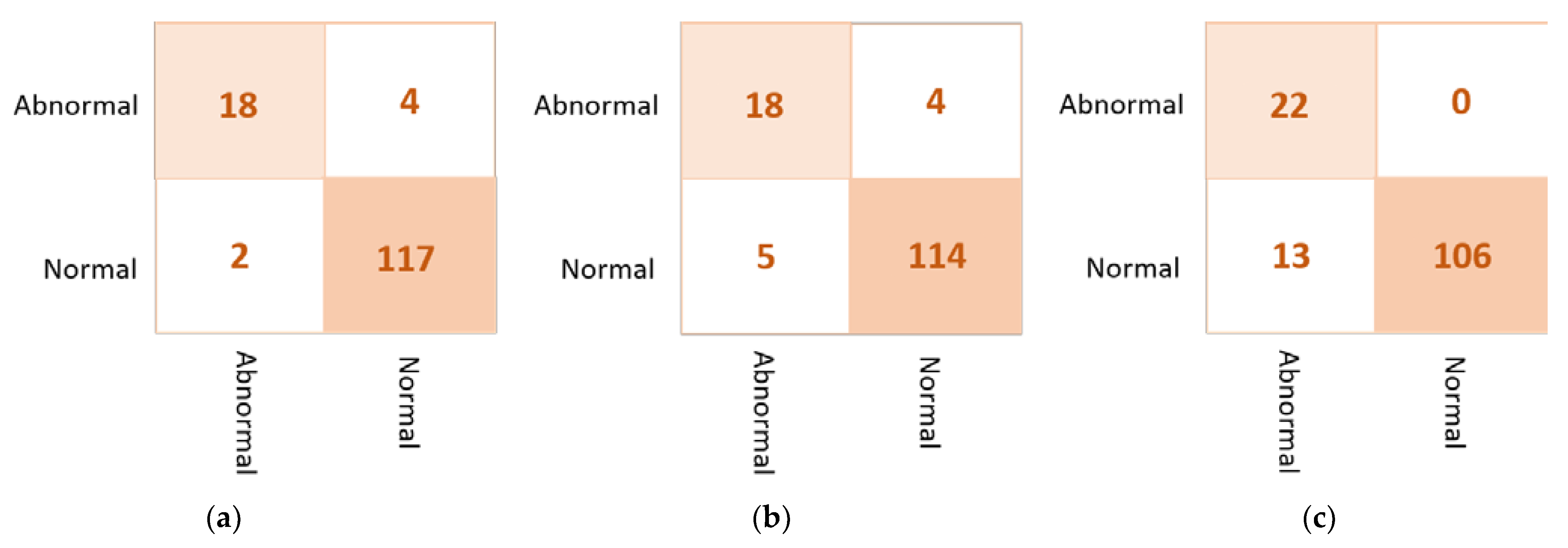

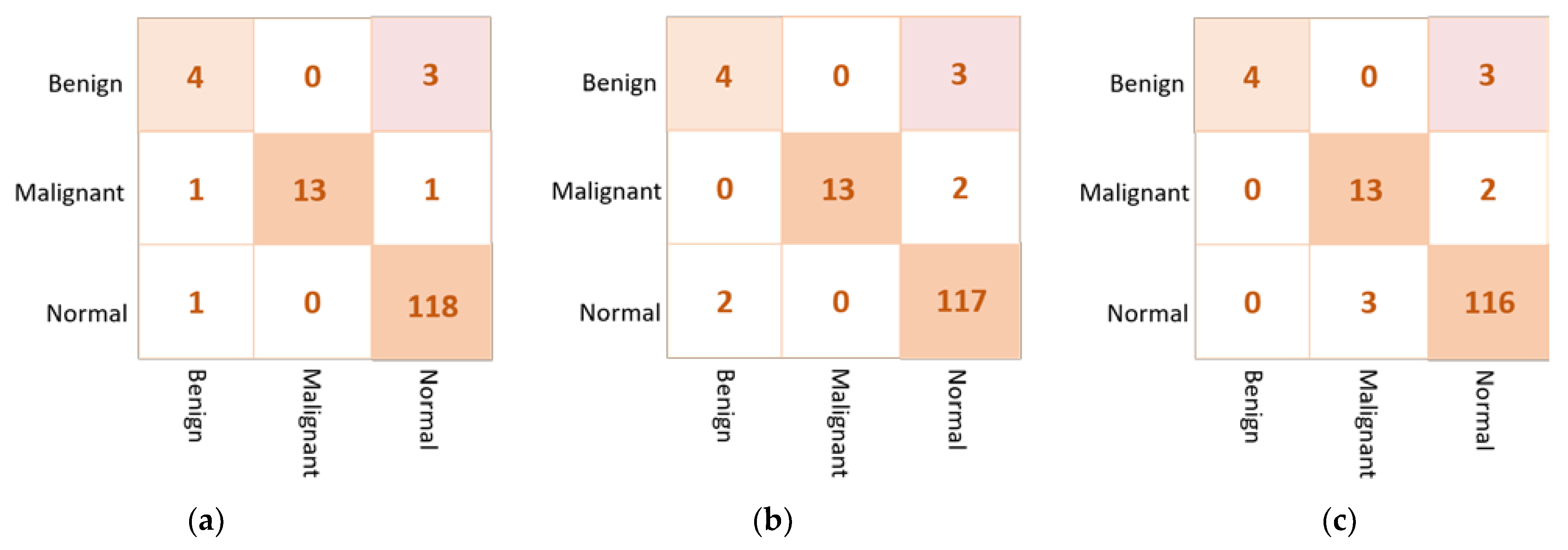
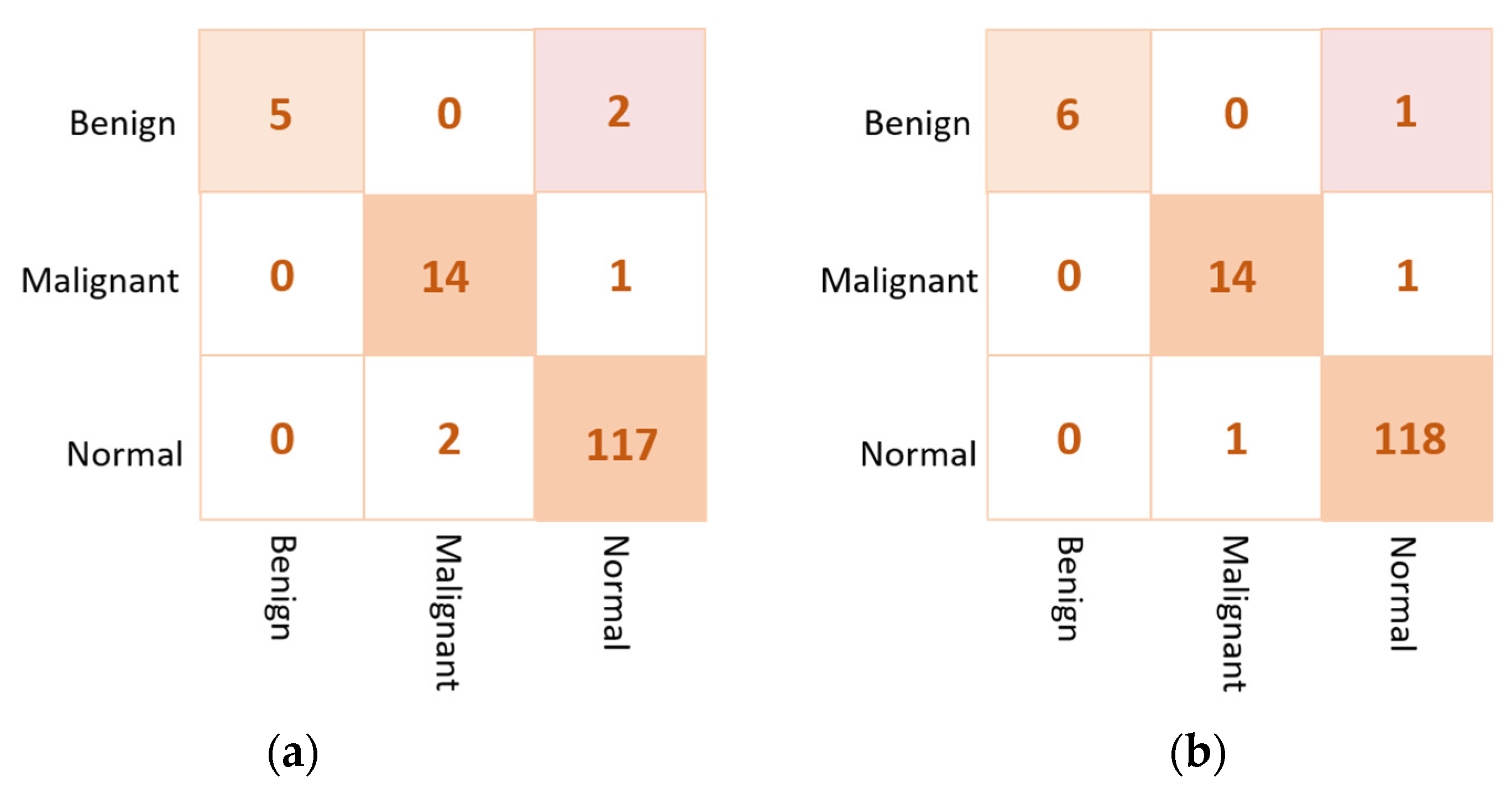
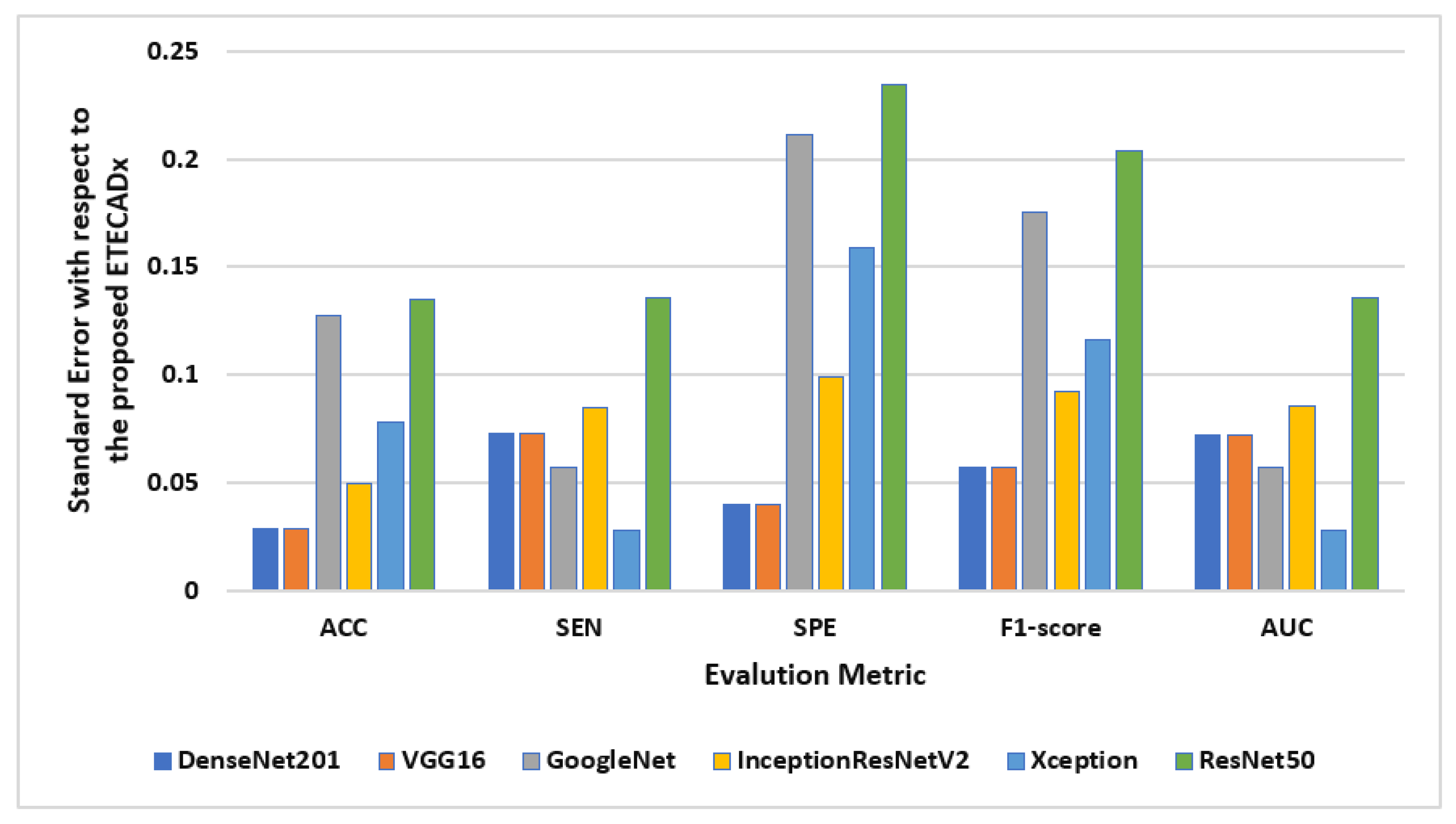
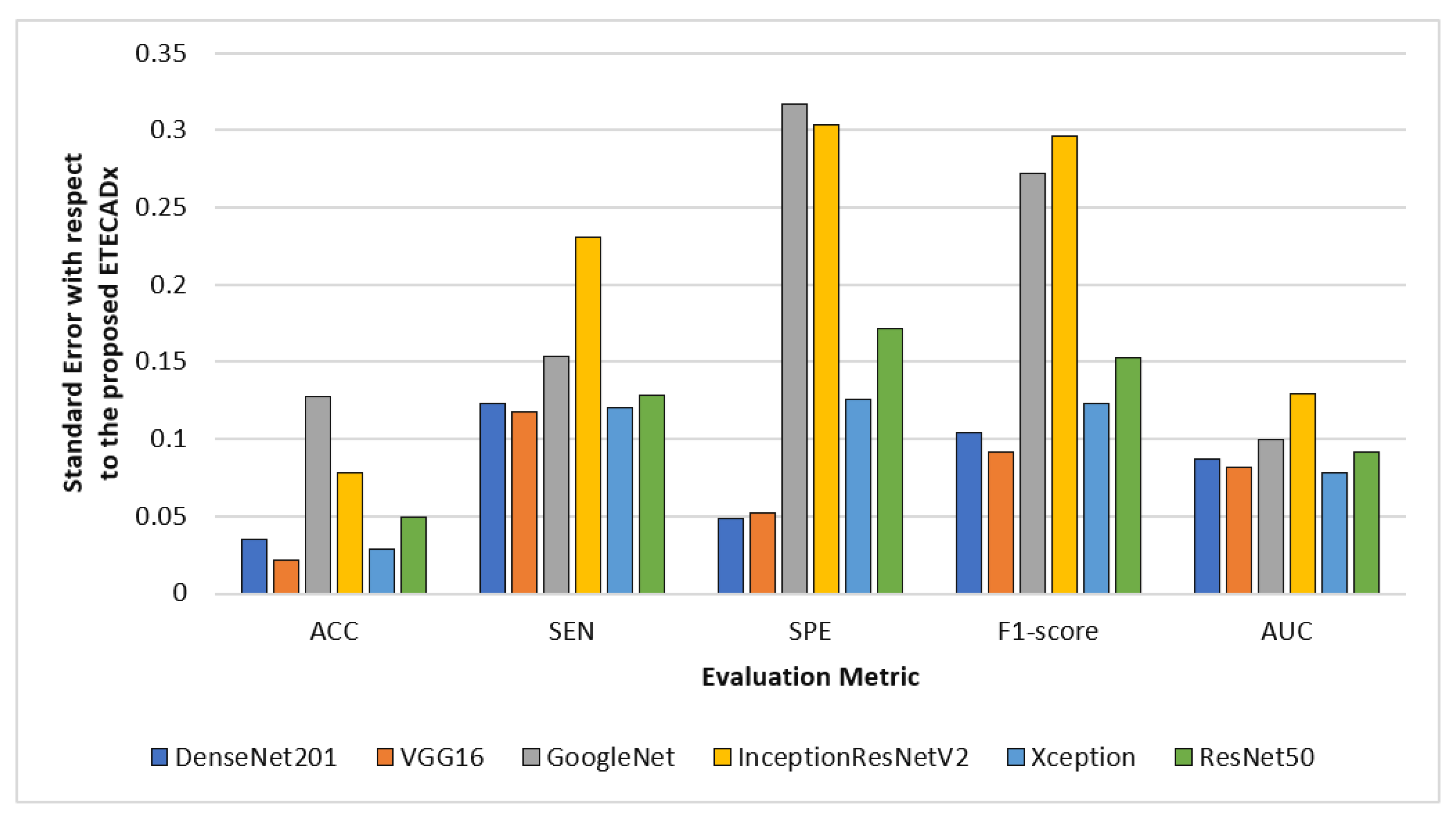
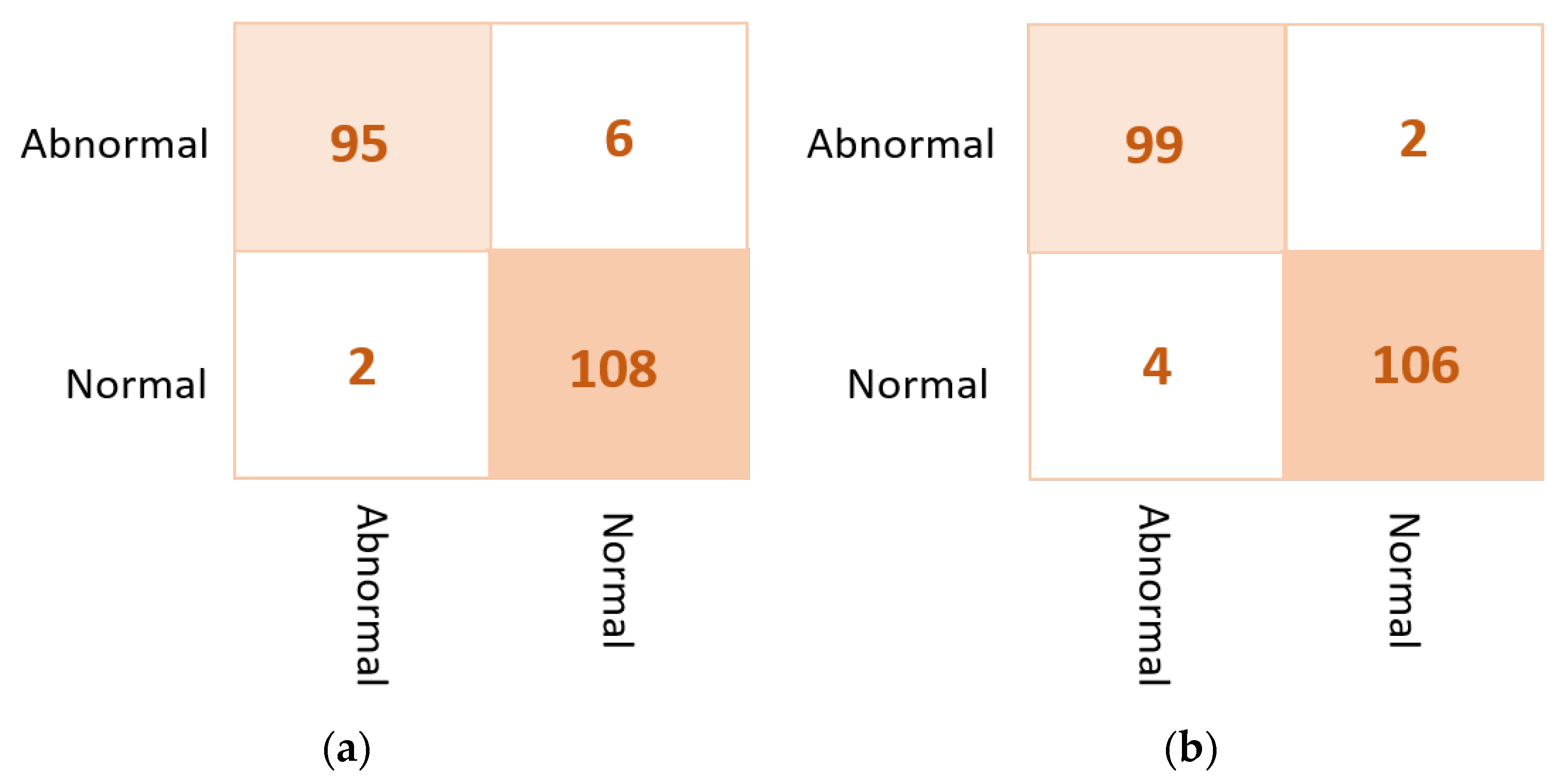
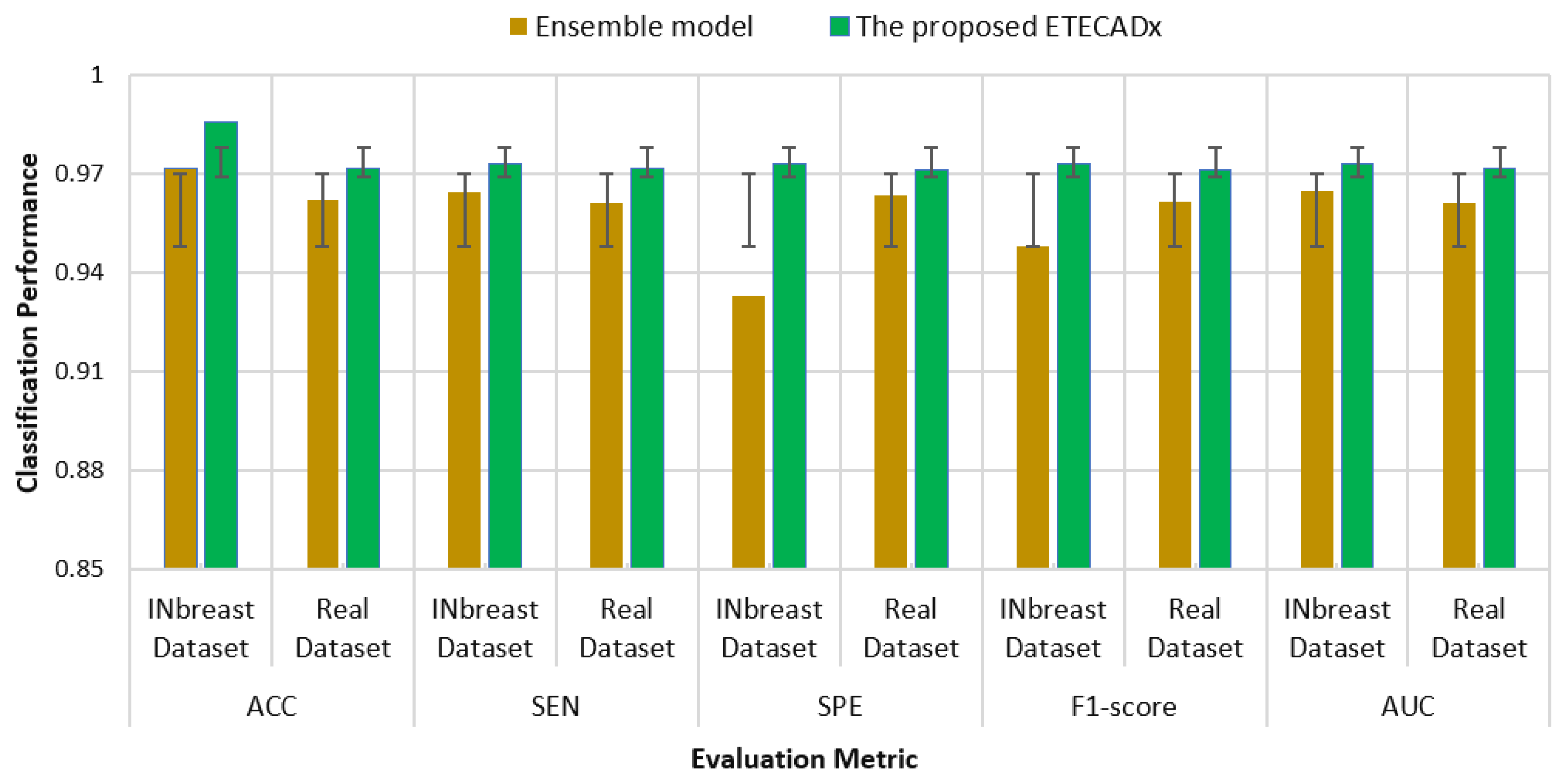
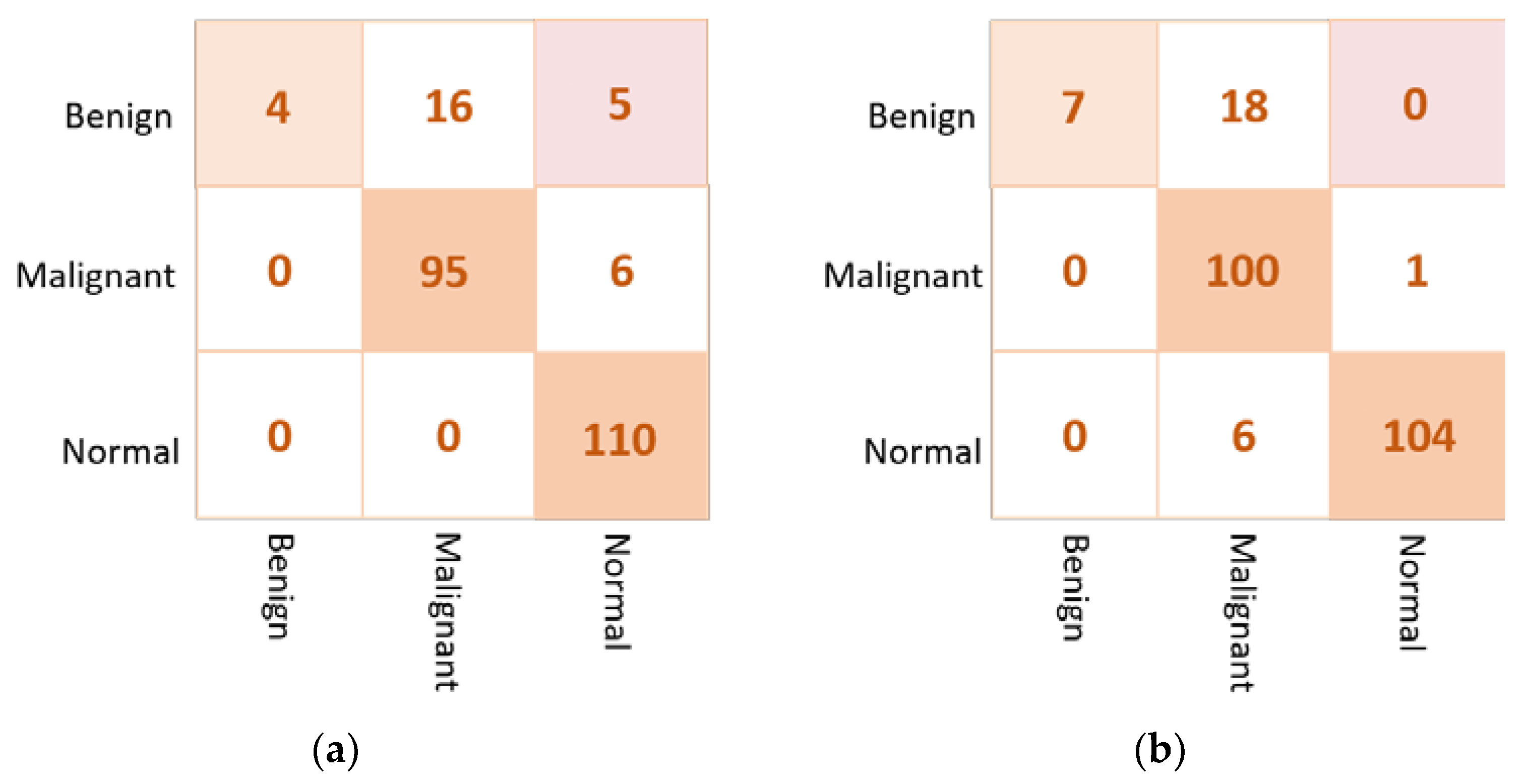
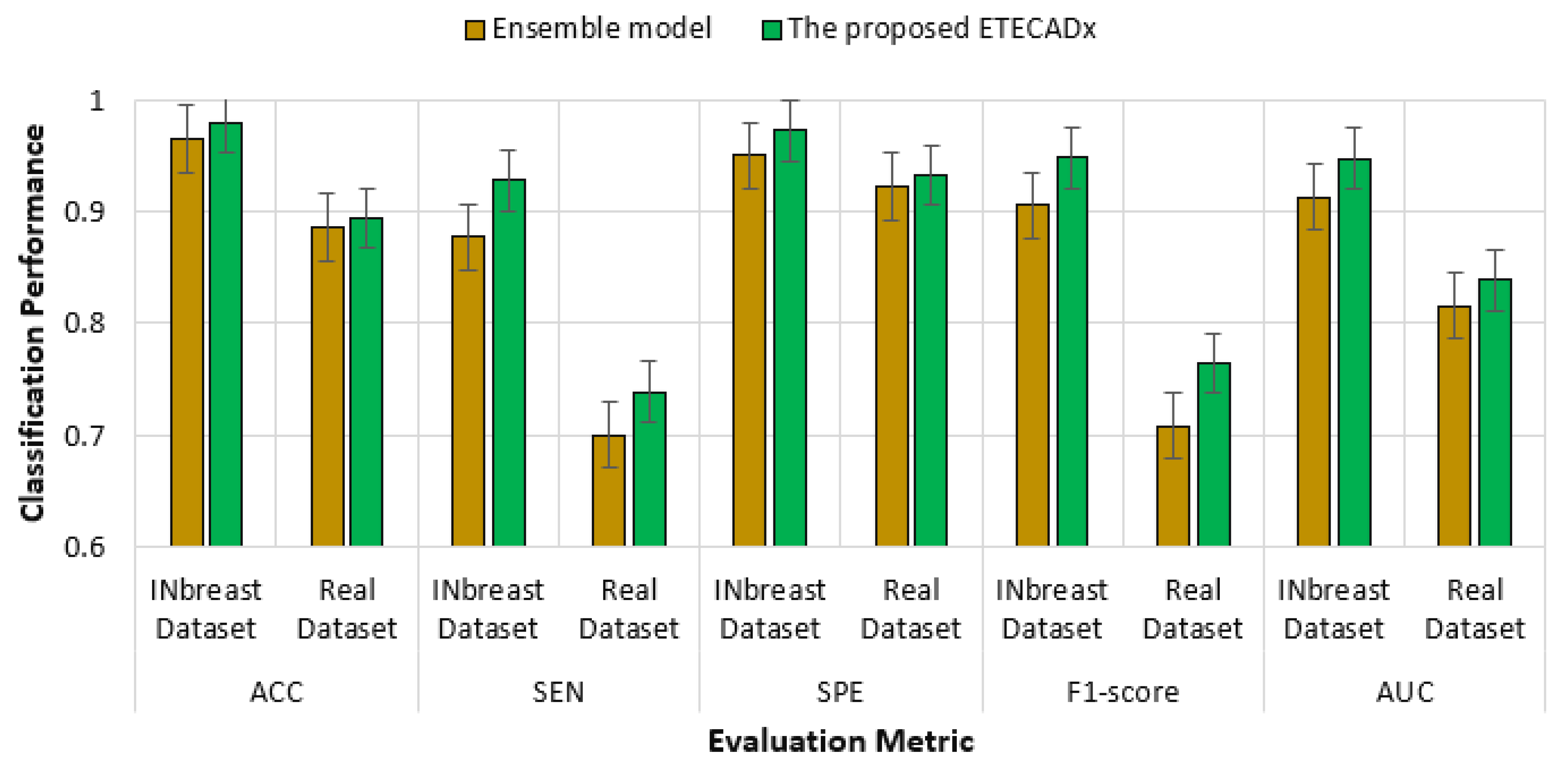
| Dataset | Evaluation Type | Annotation Type | Normal | Benign | Malignant |
|---|---|---|---|---|---|
| Dataset2-A | Internal evaluation: two local expert radiologists | Class-wise label | 100 | 54 | 126 |
| Dataset2-B * | External evaluation: international expert radiologist | Class-wise label and contour the breast tumor | 100 | 25 | 101 |
| Data Splitting | Normal | Abnormal | Total |
|---|---|---|---|
| Training (70%) | 418 | 74 | 74 |
| Training + Augmentation | 592 | 1010 | |
| Validation (10%) | 60 | 11 | 71 |
| Testing (20%) | 119 | 22 | 141 |
| Total | 597 | 625 | 1222 |
| Data Splitting | Normal | Benign | Malignant | Total |
|---|---|---|---|---|
| Training (70%) | 418 | 25 | 49 | 74 |
| Training + Augmentation | 400 | 392 | 1210 | |
| Validation (10%) | 60 | 4 | 7 | 71 |
| Testing (20%) | 119 | 7 | 15 | 141 |
| Total | 597 | 411 | 414 | 1422 |
| AI Model | ACC | SEN | SPE | F1-Score | AUC | MCC | Kappa |
|---|---|---|---|---|---|---|---|
| DenseNet201 | 0.9574 | 0.9574 | 0.9565 | 0.9566 | 0.9007 | 0.8335 | 0.8322 |
| VGG16 | 0.9574 | 0.9574 | 0.9565 | 0.9566 | 0.9007 | 0.8335 | 0.8322 |
| GoogleNet | 0.8582 | 0.8582 | 0.9257 | 0.8738 | 0.9160 | 0.6601 | 0.6070 |
| InceptionResNetV2 | 0.9362 | 0.9362 | 0.9375 | 0.9360 | 0.8881 | 0.7623 | 0.7620 |
| Xception | 0.9078 | 0.9078 | 0.9420 | 0.9157 | 0.9459 | 0.7482 | 0.7178 |
| ResNet50 | 0.8511 | 0.8511 | 0.8924 | 0.8637 | 0.8377 | 0.5672 | 0.5442 |
| AI Model | ACC | SEN | SPE | F1-Score | AUC | MCC | Kappa |
|---|---|---|---|---|---|---|---|
| Ensemble learning model | 0.9716 | 0.9716 | 0.9733 | 0.9721 | 0.9647 | 0.8973 | 0.8961 |
| The proposed hybrid ETECADx: Ensemble + ViT | 0.9858 | 0.9858 | 0.9858 | 0.9858 | 0.9731 | 0.9461 | 0.9461 |
| AI Model | ACC | SEN | SPE | F1-Score | AUC | MCC | Kappa |
|---|---|---|---|---|---|---|---|
| DenseNet201 | 0.9433 | 0.9433 | 0.9452 | 0.9412 | 0.8603 | 0.7855 | 0.7836 |
| VGG16 | 0.9574 | 0.9574 | 0.9558 | 0.9549 | 0.8658 | 0.8365 | 0.8312 |
| GoogleNet | 0.8511 | 0.8511 | 0.9185 | 0.8766 | 0.8478 | 0.5963 | 0.5709 |
| InceptionResNetV2 | 0.9007 | 0.9007 | 0.9183 | 0.9030 | 0.8179 | 0.6530 | 0.6478 |
| Xception | 0.9504 | 0.9504 | 0.9508 | 0.9500 | 0.8695 | 0.8128 | 0.8115 |
| ResNet50 | 0.9291 | 0.9291 | 0.9370 | 0.9321 | 0.8552 | 0.7423 | 0.7418 |
| AI Model | ACC% | SEN | SPE | F1-Score | AUC | MCC | Kappa |
|---|---|---|---|---|---|---|---|
| Ensemble learning model | 0.9645 | 0.9645 | 0.9656 | 0.9638 | 0.9131 | 0.8683 | 0.8676 |
| The proposed hybrid ETECADx: Ensemble + ViT | 0.9787 | 0.9787 | 0.9788 | 0.9785 | 0.9506 | 0.9210 | 0.9206 |
| AI Model | No. of Fine-Tune Layers | No. of Trainable Parameters (Million) | Training Time/Epoch (ms) | Testing Time/Image (s) | Frame Per Second (FPS) |
|---|---|---|---|---|---|
| DenseNet201 | 481 | 8.95 | 187 | 0.018 | 55.56 |
| VGG16 | 17 | 2.89 | 197 | 0.024 | 41.67 |
| GoogleNet | 252 | 12.64 | 164 | 0.009 | 250 |
| InceptionResNetV2 | 672 | 18.49 | 680 | 0.054 | 18.52 |
| Xception | 106 | 10.50 | 164 | 0.009 | 250 |
| ResNet50 | 143 | 17.08 | 169 | 0.013 | 76.92 |
| Ensemble model | 32.06 | 238 | 0.047 | 21.28 | |
| The proposed ETECADx | 25.74 | 260 | 0.048 | 20.83 |
| AI Model | No. of Fine-Tune Layers | No. of Trainable Parameters (Million) | Training Time/Epoch (ms) | Testing Time/Image (s) | Frame Per Second (FPS) |
|---|---|---|---|---|---|
| DenseNet201 | 481 | 08.95 | 195 | 0.018 | 55.56 |
| VGG16 | 17 | 02.890 | 186 | 0.02 | 50 |
| GoogleNet | 252 | 12.644 | 165 | 0.008 | 125 |
| InceptionResNetV2 | 720 | 12.384 | 174 | 0.012 | 83.33 |
| Xception | 96 | 12.119 | 150 | 0.010 | 100 |
| ResNet50 | 123 | 19.316 | 182 | 0.011 | 90.91 |
| Ensemble model | 25.491 | 270 | 0.047 | 21.28 | |
| The proposed hybrid ETECADx: Ensemble + ViT | 19.571 | 290 | 0.048 | 20.83 |
| AI Model | ACC | SEN | SPE | F1-Score | AUC | MCC | Kappa |
|---|---|---|---|---|---|---|---|
| DenseNet201 | 0.9005 | 0.9005 | 0.9164 | 0.8990 | 0.8965 | 0.8155 | 0.7988 |
| VGG16 | 0.9526 | 0.9526 | 0.9566 | 0.9524 | 0.9505 | 0.9087 | 0.9046 |
| GoogleNet | 0.7725 | 0.7725 | 0.8388 | 0.7635 | 0.7814 | 0.6116 | 0.5525 |
| InceptionResNetV2 | 0.7820 | 0.7820 | 0.8502 | 0.7734 | 0.7909 | 0.6322 | 0.5711 |
| Xception | 0.9289 | 0.9289 | 0.9323 | 0.9289 | 0.9310 | 0.8612 | 0.8580 |
| ResNet50 | 0.9573 | 0.9573 | 0.9595 | 0.9574 | 0.9587 | 0.9167 | 0.9147 |
| Ensemble model | 0.9621 | 0.9621 | 0.9627 | 0.9619 | 0.9620 | 0.9245 | 0.9239 |
| The proposed hybrid ETECADx: Ensemble + ViT | 0.9716 | 0.9716 | 0.9718 | 0.9716 | 0.9719 | 0.9432 | 0.9430 |
| AI Model | ACC | SEN | SPE | F1-Score | AUC | MCC | Kappa |
|---|---|---|---|---|---|---|---|
| DenseNet201 | 0.8771 | 0.6543 | 0.5850 | 0.6177 | 0.7899 | 0.7921 | 0.7774 |
| VGG16 | 0.8690 | 0.7798 | 0.7409 | 0.7478 | 0.8621 | 0.7831 | 0.7783 |
| GoogleNet | 0.6229 | 0.5741 | 0.6897 | 0.5652 | 0.6812 | 0.4347 | 0.3620 |
| InceptionResNetV2 | 0.6186 | 0.5278 | 0.7072 | 0.5554 | 0.6476 | 0.3343 | 0.3166 |
| Xception | 0.8771 | 0.6543 | 0.5850 | 0.6177 | 0.7899 | 0.7847 | 0.7829 |
| ResNet50 | 0.8686 | 0.7184 | 0.7293 | 0.7217 | 0.8267 | 0.7762 | 0.7744 |
| Ensemble model | 0.886 | 0.886 | 0.896 | 0.857 | 0.8158 | 0.8052 | 0.7949 |
| The proposed hybrid ETECADx: Ensemble + ViT | 0.8941 | 0.8941 | 0.9127 | 0.8777 | 0.9071 | 0.8252 | 0.8123 |
| Reference | Dataset | Classes | Prediction Method | Accuracy (%) |
|---|---|---|---|---|
| Samee et al. (2022), [3] | INbreast | Normal/Abnormal | AlexNet, VGG, and GoogleNet | 98.50 |
| Al-antari et al. (2018), [10] | INbreast | Benign/Malignant | YOLOV2 | 95.32 |
| Chakravarthy et al. (2022), [33] | INbreast | Normal/Abnormal | ICSELM | 98.26 |
| Hamed et al. (2020), [29] | INbreast | Benign/Malignant | YOLO model | 89.50 |
| Hamed et al. (2021), [24] | INbreast | Benign/Malignant | YOLOV4 | 95.0 |
| Aly et al. (2021), [22] | INbreast | Benign/Malignant | YOLO v3 | 89.40 |
| Chakravarthy et al. (2022), [18] | INbreast | Benign, Malignant, and Normal | CNNs and SVM | 96.64 |
| Shen et al. (2019), [20] | INbreast | 5-class (Normal, Benign, Malignant with mass and calcification) | Many CNN models | 86.70 (SEN) 96.10 (SPE) |
| Lee, Sanghoon, et al. (2019), [62] | The Cancer Genome Atlas (TCGA), | Tumor vs. lymphocytes | Ensemble of SVM, LR, and RF | 96.90 |
| Kadam et al. (2019), [63] | UCI WDBC dataset | Benign and Malignant | Ensemble of Sparse Autoencoders and Softmax Regression | 98.60 |
| Moon et al. (2020), [64] | Private Ultrasound dataset | Benign, Malignant, and Normal | Ensemble of VGGNet, ResNet, and DenseNet | 94.62 |
| Abbasniya et al. (2022), [65] | BreakHis | Benign and Malignant | Inception-ResNet-v2, Ensemble of (CatBoost), (XGBoost) and (LightGBM) | LightGBM has given the best average accuracy |
| Jiang et al. (2022), [66] | CBIS-DD, INbreast, MIAS | Benign and Malignant(mass/calcification) | PAA, EfficientNet-B3 and two-stage detector + image classifier | 96.30 (INbreast)89.40 (CBIS-DDSM) |
| He, Zhu, et al. (2022), [43] | BreakHis dataset | Benign and Malignant | Deconv-Transformer (DecT) | 93.02 |
| The proposed ETECADx Framework: Hybrid ensemble learning and ViT | INbreast & private real mammogram dataset | Approach A: Normal and Abnormal | The proposed AI Hybrid Model (Ensemble backbone and ViT) | 98.58 |
| Approach B: Normal, Benign, and Malignant | 97.87 |
Disclaimer/Publisher’s Note: The statements, opinions and data contained in all publications are solely those of the individual author(s) and contributor(s) and not of MDPI and/or the editor(s). MDPI and/or the editor(s) disclaim responsibility for any injury to people or property resulting from any ideas, methods, instructions or products referred to in the content. |
© 2022 by the authors. Licensee MDPI, Basel, Switzerland. This article is an open access article distributed under the terms and conditions of the Creative Commons Attribution (CC BY) license (https://creativecommons.org/licenses/by/4.0/).
Share and Cite
Al-Hejri, A.M.; Al-Tam, R.M.; Fazea, M.; Sable, A.H.; Lee, S.; Al-antari, M.A. ETECADx: Ensemble Self-Attention Transformer Encoder for Breast Cancer Diagnosis Using Full-Field Digital X-ray Breast Images. Diagnostics 2023, 13, 89. https://doi.org/10.3390/diagnostics13010089
Al-Hejri AM, Al-Tam RM, Fazea M, Sable AH, Lee S, Al-antari MA. ETECADx: Ensemble Self-Attention Transformer Encoder for Breast Cancer Diagnosis Using Full-Field Digital X-ray Breast Images. Diagnostics. 2023; 13(1):89. https://doi.org/10.3390/diagnostics13010089
Chicago/Turabian StyleAl-Hejri, Aymen M., Riyadh M. Al-Tam, Muneer Fazea, Archana Harsing Sable, Soojeong Lee, and Mugahed A. Al-antari. 2023. "ETECADx: Ensemble Self-Attention Transformer Encoder for Breast Cancer Diagnosis Using Full-Field Digital X-ray Breast Images" Diagnostics 13, no. 1: 89. https://doi.org/10.3390/diagnostics13010089
APA StyleAl-Hejri, A. M., Al-Tam, R. M., Fazea, M., Sable, A. H., Lee, S., & Al-antari, M. A. (2023). ETECADx: Ensemble Self-Attention Transformer Encoder for Breast Cancer Diagnosis Using Full-Field Digital X-ray Breast Images. Diagnostics, 13(1), 89. https://doi.org/10.3390/diagnostics13010089









